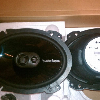I do agree with CDW about A/F ratio but restriction is a direct result in high tq numbers. Open up the exhaust and you will lose tq but you gain hp. The more air in and exhaust out=HP. Back pressure will give you TQ but not be an efficient running motor. I have an 03 cobra I ported the blower went to a smaller pulley and increased my boost by 0 lbs. However I gained 60hp but not any significant TQ. Boost is just a calculation of back pressure I could stick a stock exhaust on and gain 3 lbs of boost. It would not result in more HP though. It would give me higher TQ numbers but lower my HP. What is important is the amount of air you are moving. When in doubt check your plugs they should be brown not black indicating rich and not white indicating lean. You are better of rich then lean if you are to lean you can melt a piston.
Are you trying to say it would move the power band downward? if so, i agree with you, to a point - it WOULD move the top of the bell curve (of power output) downward, but only because it would be squelching the top end more, which may (by comparison) make it feel like it has more bottom end.
as far as "less torque but more horsepower" that's sort of a conflicted statement, because torque and horsepower are the exact same thing, "horsepower" is just a way of expressing torque numbers at a given RPM, while figuring the working power based on that RPM.
for instance, 10 ft/lb of torque at 5250 rpm's is 10 horsepower. if you double the RPM (and maintain 10 ft/lb of torque) the horsepower will double in result. if you cut the RPM in half, the horsepower number will become half.
as for the "more exhaust flow = lean" statement, i have not heard (or looked into) this before, but it seems to me that it would only apply in a speed density style injected car. MAF i believe would maintain proper a/f ratio with the added flow, the same way it does when the internal VE of the engine is raised (to an extent) by ported heads etc. of course, you could always raise the fuel pressure in the rail slightly if you wanted. i'm definitely going to look into this theory further though.
on a carb'd car thought, i don't see added flow changing the tune of the carb any, since the carb jets fuel based (crudely) on the air volume passing through the carb. the carb doesn't really care how big the engine is either (with the exception of the obvious, which is that it has enough cfm volume to feed that engine, or isn't so huge the velocity is horrible)
ohh, and fwiw, i believe the "header/manifolds" or whatever they are on a '98 5.0 are pretty good.. they dont look restrictive to me at all.










